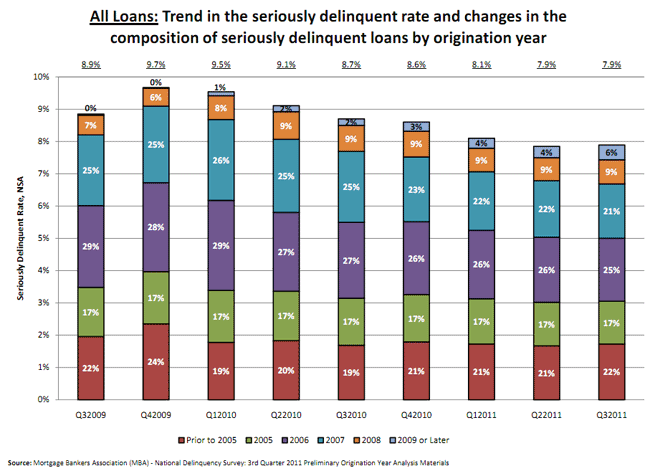Seasonally adjusted mortgage delinquencies fell 45 basis points (bp) from the second to the third quarter of 2011 to a seasonally adjusted rate of 7.99 percent, the lowest level recorded by the Mortgage Bankers Association's (MBA) National Delinquency Survey (NDS) since the fourth quarter of 2008. The rate is 114 bp below the level at the end of the third quarter of 2010. The 3rd Quarter NDS released today reported the non-seasonally adjusted delinquency rate was up 9 bp to 8.20 percent.
Early stage (30+ days) delinquencies declined 27 bp to 3.19 percent on a seasonally adjusted basis, the 60+ day bucket was down 7 bp to 1.30 percent and 90+ day loans were down 11 bp to 3.50 percent.
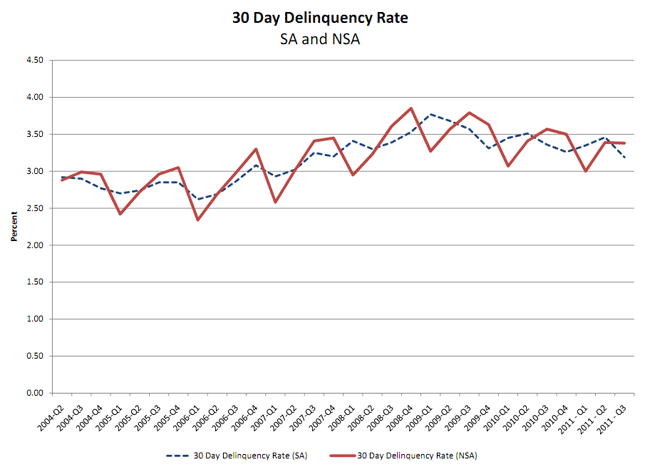
Delinquency rates dropped across all loan types with Subprime loans showing the greatest improvement. Subprime fixed-rate mortgages (FRM) were down 138 bp from Q2 to 21.21 percent and adjustable rate mortgages (ARM) fell 211 bp to 25.07 percent. Prime FRM and ARMs were down 42 bp to 4.32 percent and 103 bp to 10.73 percent respectively. FHA and VA loans, while improving, did not fare as well. FHA loans are now at a 12.09 percent delinquency rate following a 53 bp drop and VA loans were down 47 bp to 6.58 percent.
The delinquency rate includes loans that are at least one payment in arrears but does not include loans in the process of foreclosure. Taken together the two categories have a non-seasonally adjusted rate of 12.63 percent, up 9 bp from Quarter Two but 115 bp lower than the third quarter of 2010.
Seriously delinquent (90+ days) loans declined by 11 bp as foreclosure starts rose 12 basis points indicating that some servicers had begun picking up the pace of foreclosures as loans left the loss-mitigation process and state foreclosure moratoria ended. Foreclosure starts were at a non-seasonally adjusted rate of 1.08 percent compared to .96 percent in the second quarter and 1.34 percent a year earlier.
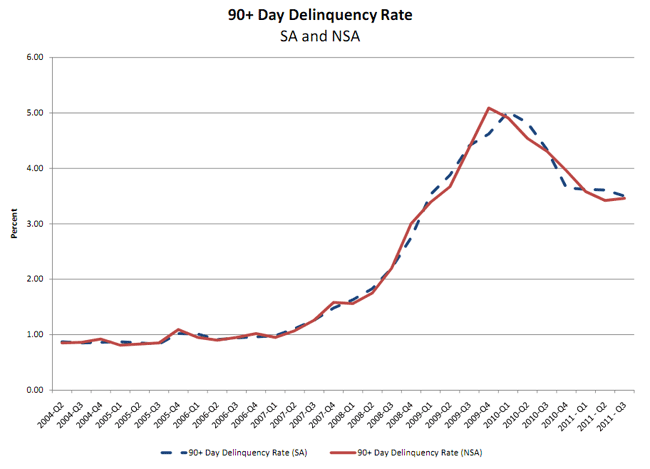
Foreclosure starts, non-seasonally adjusted, increased 7 bp for prime fixed loans to 0.69 percent, 34 bp for prime ARM loans to 2.16 percent, 6 bp for subprime fixed to 2.50 percent, and 103 bp to 4.65 percent for subprime ARMs. The foreclosure starts rate for FHA loans was up 5 bp to 0.78 percent for 1 bp for VA loans to 0.56 percent.
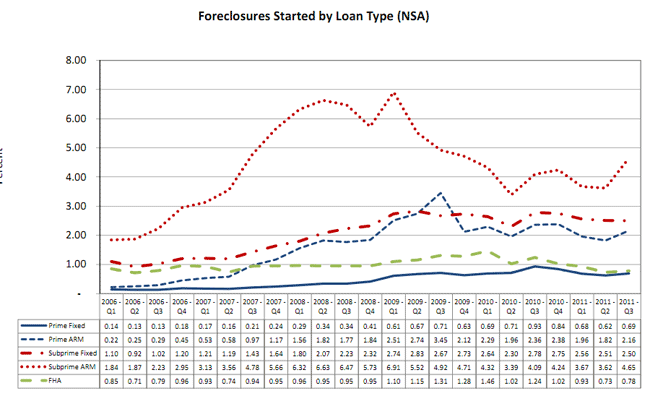
MBA states that it is difficult to interpret the seasonal effects in data with quarter to quarter comparisons so it is necessary to look at year-over-figures as well. Compared with the third quarter of 2010, non-seasonally adjusted foreclosure starts decreased 24 bp for prime FRM, 20 bp for prime ARM, 28 bp for subprime fixed, 46 bp points for FHA loans, and 30 bp for VA loans. The rate increased 56 bp for subprime ARM loans.
The foreclosure inventory stands at 4.43 percent, unchanged from the second quarter and up 4 bp from one year ago. Mike Fratantoni, MBA's Vice President for Research and Economics told a press conference accompanying the NDS release that the flat inventory rate is actually obscuring two underlying trends. The inventory in states using a judicial form of foreclosure stands at 6.8 percent and is rising while the inventory in non-judicial states is 2.9 percent and trending down. Of the ten states with a higher level of loans in foreclosure than the U.S. as a whole, nine of them are judicial foreclosure states. Fratantoni said that foreclosure inventories in those states are a legal issue rather than one of economics.
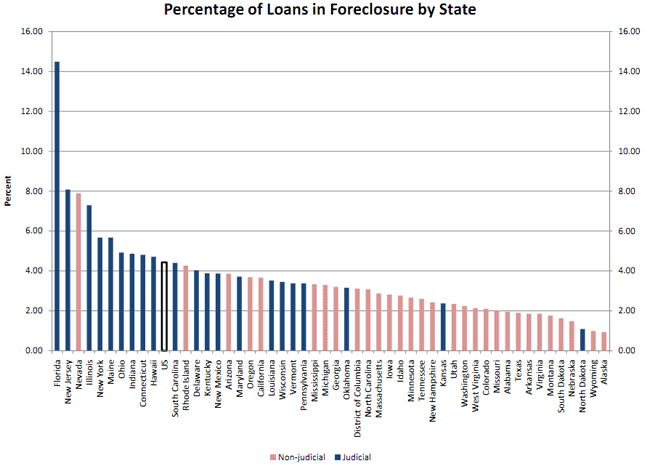
As can be seen from the chart above, Florida is still having an enormous foreclosure problem. The current inventory in that state stands at 14.49 percent, more than three times the national average of 4.43 percent and nearly double that of the next highest state, New Jersey. While the state has 7.5 percent of the loans serviced in the U.S. it has 24.5 percent of the foreclosure inventory. Florida along with four other states, California, Illinois, New York and New Jersey have 52.8 percent of foreclosures but only 32.2 percent of all loans serviced.
Fratantoni said that, even as overall delinquencies have decreased, the percentage across loan vintages has remained remarkably consistent. Loans originated before 2005 constituting less than a quarter of loans while the 2005-2007 vintages make up well over half of the problem loans. The 2008-2010 classes of loans are now entering what Fratantoni called the peak default years - three to four years following origination - but so far appear to be performing well which, he said, portends well for gradually working out of the inventory.
Recent FHA loans, however, are performing less well. More than half of the delinquent FHA loans are loans originated in 2008 or later. In part this reflects the surge of loans that FHA has written since credit tightened, at times financing nearly 50 percent of all mortgages in the country. However, these figures bear watching.
Fratantoni said that MBA does not expect more than modest job growth over the next months but that even the current rate is enough to keep the delinquency rate moving down. He expects, however, that it will take three to four years to return serious delinquency rates to the historic levels of around 1 percent.
The MBA surveys 120 servicing companies for the NDS. The survey covers about 88 percent of all loans serviced, approximately 43.5 million loans. The number of loans has declined 1.8 percent or 358,000 loans since the second quarter and 440,000 from one year ago.
